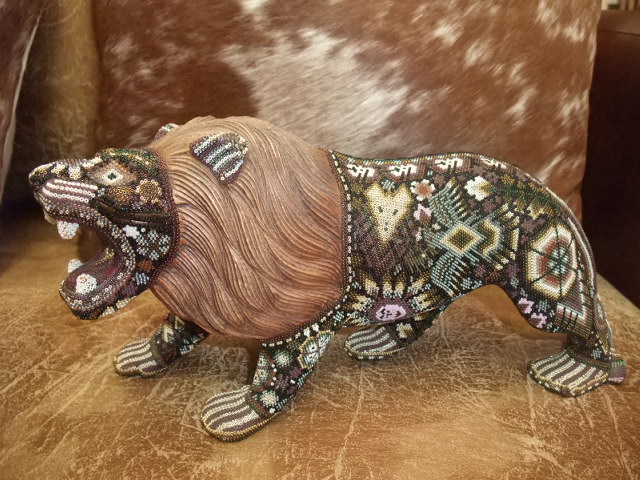
Share This article

For over 20 years, Xanadu Santa Fe has been a beacon for art enthusiasts in New Mexico, offering a unique collection of authentic and culturally rich pieces. Among these treasures is the exquisite “Lion Huichol Tiny Beaded” artwork. Let’s get into the fascinating world of Huichol art, exploring the significance of this tiny beaded lion, the intricate process behind its creation, and its cultural importance.
The Huichol people, also known as Wixárika, are an indigenous group from the mountainous regions of western Mexico, primarily in the states of Jalisco, Nayarit, Zacatecas, and Durango. They have a rich cultural heritage, deeply rooted in their spiritual beliefs and artistic expressions.
Huichol beadwork is a vibrant and intricate art form that dates back centuries. Traditionally, the Huichol people used materials like seeds, shells, and stones to create their beadwork. Today, tiny glass beads known as Chaquira are commonly used, allowing for more detailed and colorful designs.
Creating Huichol beadwork involves a meticulous process. Artists use a combination of beeswax and resin to attach the beads to a surface, often wood or gourds. The designs are created by pressing the beads into the wax, forming intricate patterns and symbols.
Each beadwork piece is rich with symbolism. Colors and patterns are chosen carefully to represent various elements of Huichol cosmology. Common symbols include deer, eagles, and peyote plants, each carrying spiritual significance.
The “Lion Huichol Tiny Beaded” piece is a stunning example of Huichol art. Measuring just a few inches, this miniature masterpiece features a lion, a powerful symbol in many cultures. The lion’s form is meticulously covered in vibrant beads, creating a mesmerizing mosaic of colors and patterns.
In Huichol culture, animals often hold spiritual meanings. While the lion is not native to the Huichol homeland, it represents strength, courage, and leadership. Adding the lion into their beadwork showcases the Huichol artists’ ability to blend their traditional symbols with broader, universally recognized icons.
The beadwork on this tiny lion is incredibly detailed. Each bead is carefully placed to form intricate patterns, with colors that often represent elements of nature and spiritual concepts. The use of bright, contrasting colors makes the piece visually striking and a testament to the skill of the Huichol artisans.
Creating Huichol beadwork is a time-consuming process that requires patience and precision. A single piece can take several days or even weeks to complete, depending on its size and complexity. The artisans’ skill is evident in the uniformity and intricacy of the bead placement.
Huichol beadwork is not merely decorative; it holds deep spiritual significance. Many pieces are created for use in rituals and ceremonies, serving as offerings to deities or as tools in shamanic practices. The patterns and symbols often tell stories or convey prayers.
While the lion is not a traditional Huichol symbol, its inclusion in this artwork signifies a blending of cultural elements. In a broader sense, the lion represents power and protection, qualities that resonate with Huichol spiritual beliefs.
Each piece of Huichol beadwork is a reflection of the artist’s spiritual journey and cultural heritage. The designs often incorporate visions from peyote rituals, a central aspect of Huichol spirituality. The intricate patterns are more than just art; they are a visual expression of the Huichol worldview.
Huichol art has gained international recognition, influencing contemporary art and fashion. Designers and artists worldwide draw inspiration from the vibrant colors and intricate patterns of Huichol beadwork, incorporating these elements into their creations.
Various organizations and initiatives are dedicated to preserving Huichol traditions. These efforts include providing platforms for Huichol artists to showcase their work, educational programs to teach younger generations, and collaborations with museums and galleries.
Online platforms like Xanadu Santa Fe play a crucial role in promoting Huichol art. By offering these unique pieces to a global audience, they help support Huichol artists and ensure the continuation of their cultural traditions.
By purchasing authentic Huichol beadwork, you support the artists and their communities. This financial support helps sustain their way of life and allows them to continue creating these beautiful artworks.
To ensure your Huichol beadwork lasts, keep it away from direct sunlight and moisture. Gently wipe it with a soft cloth and steer clear of harsh chemicals. Proper care will preserve the vibrant colors and intricate designs.
The “Lion Huichol Tiny Beaded” artwork is more than just a beautiful piece; it is a testament to the rich cultural heritage and artistic skill of the Huichol people. By understanding and appreciating the art of the Huichol, we not only support their traditions but also enrich our own cultural experiences. Visit Xanadu Santa Fe to explore this and other stunning pieces of Huichol art.
Huichol art is a form of artistic expression created by the Huichol people of Mexico. It includes beadwork, yarn paintings, and other crafts, often featuring intricate patterns and vibrant colors.
Huichol beadwork is made by applying tiny glass beads to a surface coated with a mixture of beeswax and resin. The beads are placed one by one to create detailed designs.
While not a traditional Huichol symbol, the lion in this beadwork represents strength, courage, and leadership, reflecting universal qualities recognized across cultures.
You can support Huichol artists by purchasing authentic Huichol art from reputable sources, such as Xanadu Santa Fe. This helps sustain their communities and preserve their cultural traditions.